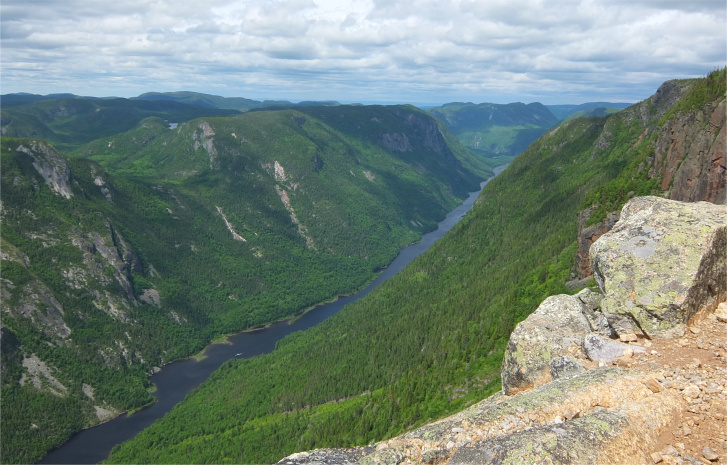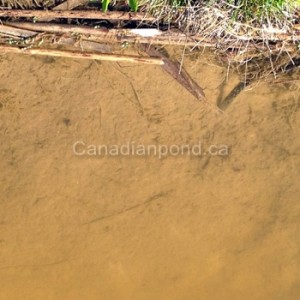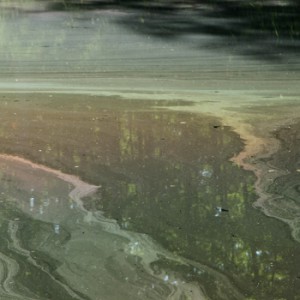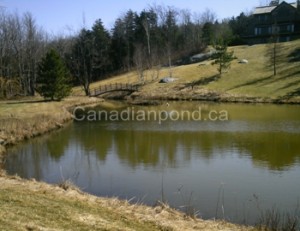Tips from the Limnologist: Protecting Your Pond’s Watershed
Here at Canadianpond we are dedicated to ensuring that your pond or lake water quality is at its best no matter what.

It is for this reason that we wish to inform you, our fellow pond owners, of a problem that we feel needs to be addressed. This problem is that of unprotected watersheds. In many of our travels around Canada as well as other countries, we have found that the root cause of water quality issues often lies on land and not within the water itself.
What we mean by unprotected watersheds is that the land surrounding and draining into your pond is unsuitable and allows for nutrients to flow unhindered into your pond and/or allows soil erosion to occur. These unprotected watersheds may have highly modified land, that is, if you cut your lawn all the way to the edge of your pond you may be at risk to have water quality issues. Short grass and little diversity in vegetation is one of the easiest ways to transport nutrients from your lawn to the water. This lack of thick vegetation allows for greater runoff into your pond during rain events. It allows rain to wash fertilizer, soil, and organic matter into your pond. These substances cause algal blooms, murky water and a lack of oxygen just to name a few issues.
Nutrients such as Phosphorus and Nitrogen are food for algae and, when they are present in high amounts, blooms of green algae as well as cyanobacteria (blue-green algae) can appear. These organisms may produce toxins which are harmful to consume and have been known to kill pets and other animals. One of the big issues that we see is the combination of fertilizer sources upstream or uphill of a pond and a lack of a proper zone of thick vegetation. This combination usually ensures that we at Canadianpond will be asked for help!
Soil erosion is the second big effect caused by unprotected watersheds. Roots from an area of thick vegetation act to anchor the soil into place. This prevents soil from washing into the bottom of your pond. This is undesirable for two reasons: The first reason is that you will lose land from your watershed to your pond. The second reason is that it could lead to murky water and sedimentation.  Loss of land is a serious problem for aesthetic and structural reasons, but our expertise lies in the sedimentation and murky water problems. In this case, soil is washed into the water and remains suspended. This is what gives your water that brown colour. Also, the soil eventually settles on the bottom of your pond and builds up over time. Buildup of sediment is a problem because it means that your pond may become considerably shallower. Shallower water is heated more easily and increases the likelihood that algal blooms form and that oxygen will be depleted. This will make your pond unsuitable for fish such as trout, as well as going further in its state of eutrophication.
Loss of land is a serious problem for aesthetic and structural reasons, but our expertise lies in the sedimentation and murky water problems. In this case, soil is washed into the water and remains suspended. This is what gives your water that brown colour. Also, the soil eventually settles on the bottom of your pond and builds up over time. Buildup of sediment is a problem because it means that your pond may become considerably shallower. Shallower water is heated more easily and increases the likelihood that algal blooms form and that oxygen will be depleted. This will make your pond unsuitable for fish such as trout, as well as going further in its state of eutrophication.
One final problem that I will touch upon here is the loss of oxygen in your pond. This is not directly due to an unprotected watershed but rather occurs in the presence of high organic load and heat. These two factors can join together to form a large algae bloom. In daytime algae produces oxygen in much the same way trees do. The problem arises, however when there is so much algae that a large quantity of dead cells sink to the bottom. These cells decompose and consume oxygen at the bottommost layer of the pond. This loss of oxygen creates a whole host of problems that you may read about in our aeration and water treatments sections, but the important message is that water which lacks oxygen creates a dead zone where many animals of the ecosystem cannot survive. This is one of the most important water quality issues to watch out for.
So now that you know a bit behind why watersheds need to be protected, you should know how to protect your watershed and learn some of the Do’s and Don’t’s of watershed management.
The Do’s of watershed management:
- Plant a diverse and thick amount of vegetation around your pond
- Verify that there is no obvious sources of nutrients upstream of your pond (remove them if possible).
- Remember that some aquatic plants near shore actually help filter out nutrients from the open water and can be a very important part of your pond’s ecosystem by providing some oxygen during daytime.
The Do Not’s of watershed management:
- DON’T mow to the edge of your pond all the way around, as this will hinder the ability of plants to intercept nutrients and will add to nutrient inputs.
- DON’T cut trees surrounding your pond. Not only do their roots hold soil in place at the same time as sucking in nutrients, they also provide shade to your water and keep it cooler and limiting algae’s growth.
- DON’T apply fertilizer or any other source of nutrients upstream or uphill of your pond. Even natural organic compost is a high nutrient source that can boost algae growth once in the pond.

Remember this regarding watershed management:
- Fertilizer is fertilizer. Whether organic or non organic, your pond cannot distinguish between types of fertilizer. The key to good water quality is limiting nutrient inputs as much as possible. If all those nutrients are making their way into your pond instead of your lawn anyway, it might be more cost effective to stop fertilizing altogether.
- When all else fails don’t hesitate to contact us at CanadianPond!
Related Articles: